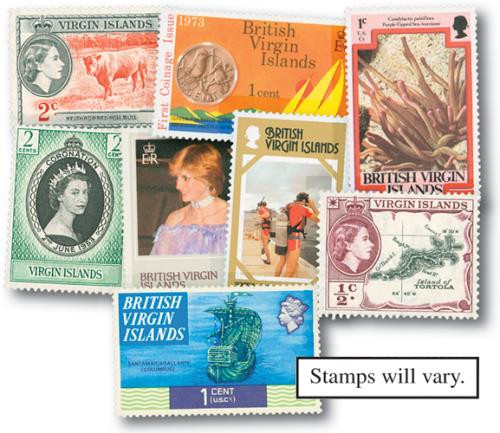
# M2198 - Lundy Island Puffin Stamps, 6 stamps
Get 6 Interesting and Unusual Lundy "Puffin" Stamps
Lundy is a British island in the Bristol Channel with an odd history. In fact, while technically always administered by Britain, it was privately owned by several people over the years.
One of Lundy's most interesting owners was Martin Coles Harman, who bought the island in 1924 and proclaimed himself king! He even issued his own coins, violating Britain's Coinage Act of 1870. Harman was tried and found guilty in 1931, fined five pounds, and forced to remove the coins from circulation.
Another interesting creation of Harman's were Lundy stamps, first issued November 1, 1929. These stamps were printed two years after the British postal system stopped servicing the island due to its dwindling population. Harman covered the cost of moving mail personally from 1927 to 1929, but then decided to require payment from customers in the form of Local stamps.
Harman decided, rather than use a standard denomination like regular postage stamps, Lundy's stamps would be in "puffins," with one puffin equivalent to one British penny. "Puffin" was likely chosen in response to "Lundy" being the old Norse word for "puffin island." (Plus many of these aquatic birds could be found on Lundy at this time.)
The first Lundy stamps were a 1/2 puffin (pink) and a 1 puffin (blue). Each stamp pictured the same number of birds as the denomination. At the time, customers were required to stick the stamps on the reverse side of the envelope, per regulations by the British postal system.
Puffin stamps of increasing face value have been released over the years and are still issued today. The stamps may now be placed on the front of postcards and letters. They simply cannot be too close to the British stamp (needed for the correspondence to reach its destination from the mainland).
Early Lundy stamps have become highly sought-after by many collectors today. Several specialty catalogs have been created for them inluding Stamps of Lundy Island by Stanley Newman in 1984 and Labbe's Specialized Guide to Lundy Island Stamps in 2005. The latter is said to be the best of the Lundy catalogs as it thoroughly researches different varieties, errors, special items, and "fantasy" issues.
The British Library Philatelic Collections holds the Chinchen Collection of Lundy stamps (donated by Barry Chinchen in 1977). The library also houses the Landmark Trust Lundy island Philatelic Archive. This archive features Lundy artwork, literature, essays, postmarking devices, and issued stamps.
Get 6 Interesting and Unusual Lundy "Puffin" Stamps
Lundy is a British island in the Bristol Channel with an odd history. In fact, while technically always administered by Britain, it was privately owned by several people over the years.
One of Lundy's most interesting owners was Martin Coles Harman, who bought the island in 1924 and proclaimed himself king! He even issued his own coins, violating Britain's Coinage Act of 1870. Harman was tried and found guilty in 1931, fined five pounds, and forced to remove the coins from circulation.
Another interesting creation of Harman's were Lundy stamps, first issued November 1, 1929. These stamps were printed two years after the British postal system stopped servicing the island due to its dwindling population. Harman covered the cost of moving mail personally from 1927 to 1929, but then decided to require payment from customers in the form of Local stamps.
Harman decided, rather than use a standard denomination like regular postage stamps, Lundy's stamps would be in "puffins," with one puffin equivalent to one British penny. "Puffin" was likely chosen in response to "Lundy" being the old Norse word for "puffin island." (Plus many of these aquatic birds could be found on Lundy at this time.)
The first Lundy stamps were a 1/2 puffin (pink) and a 1 puffin (blue). Each stamp pictured the same number of birds as the denomination. At the time, customers were required to stick the stamps on the reverse side of the envelope, per regulations by the British postal system.
Puffin stamps of increasing face value have been released over the years and are still issued today. The stamps may now be placed on the front of postcards and letters. They simply cannot be too close to the British stamp (needed for the correspondence to reach its destination from the mainland).
Early Lundy stamps have become highly sought-after by many collectors today. Several specialty catalogs have been created for them inluding Stamps of Lundy Island by Stanley Newman in 1984 and Labbe's Specialized Guide to Lundy Island Stamps in 2005. The latter is said to be the best of the Lundy catalogs as it thoroughly researches different varieties, errors, special items, and "fantasy" issues.
The British Library Philatelic Collections holds the Chinchen Collection of Lundy stamps (donated by Barry Chinchen in 1977). The library also houses the Landmark Trust Lundy island Philatelic Archive. This archive features Lundy artwork, literature, essays, postmarking devices, and issued stamps.











